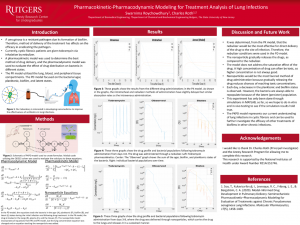Roychowdhury, Swarnima: Pharmacokinetic-Pharmacodynamic Modeling for Treatment Analysis of Lung Infections
Title: Pharmacokinetic-Pharmacodynamic Modeling for Treatment Analysis of Lung Infections
Name: Swarnima Roychowdhury
Major: Biomedical Engineering
School affiliation: School of Engineering
Programs: Aresty Summer Science Program
Other contributors: Charles Roth
Abstract: Cystic fibrosis (CF) patients suffer chronic infections in their clogged lung airways due to build up of excess mucus and fluid. The most prevalent bacterial infections in adult CF patients are Pseudomonas aeruginosa. Currently, tobramycin is the main drug used to treat Gram-negative lung infections in CF. As mucus clearance is inhibited in CF patients, drugs such as tobramycin that are normally effective against P. aeruginosa are not able to penetrate and eradicate the infection, a problem caused by the formation of bacterial biofilms within these mucus layers. Improved methods of administering the drugs may lead to better outcomes in treating these infections.
There are multiple ways to administer the drug, including IV or inhalation. Inhalation using aerosols seems to be the most promising for direct delivery of the drug to the site of infection. We used pharmacokinetic and pharmacodynamic (PKPD) modeling to understand better the interplay between formulation and administration strategies and bacteria populations in the planktonic, biofilm, and latent states. The pharmacokinetic model indicated that the aerosol would be the best administration of tobramycin. Furthermore, our pharmacodynamic model incorporated the drug cytotoxic effect on the bacteria via aerosol administration. This model indicated that, while successive doses of nebulized tobramycin killed off most of the planktonic bacteria, the bacteria persisted in the biofilm and latent states even after five daily administrations. Currently, we are in the process of incorporating nanoparticles into the model, where the nanoparticle will carry the drug to the lungs and release it in a sustained manner. In vitro and in vivo testing will be used to further validate these simulation results. These simulations are intended to contribute to the design of an aerosolized nanomedicine for improved treatment of lung infections in CF.
